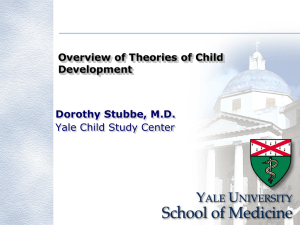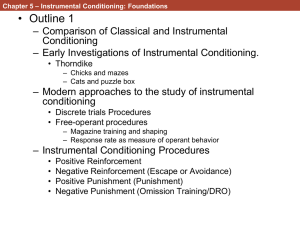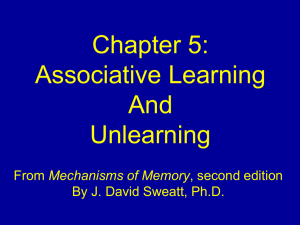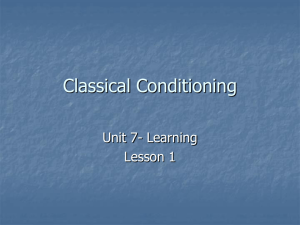The Mind-Body Problem and Current Behavioral
advertisement
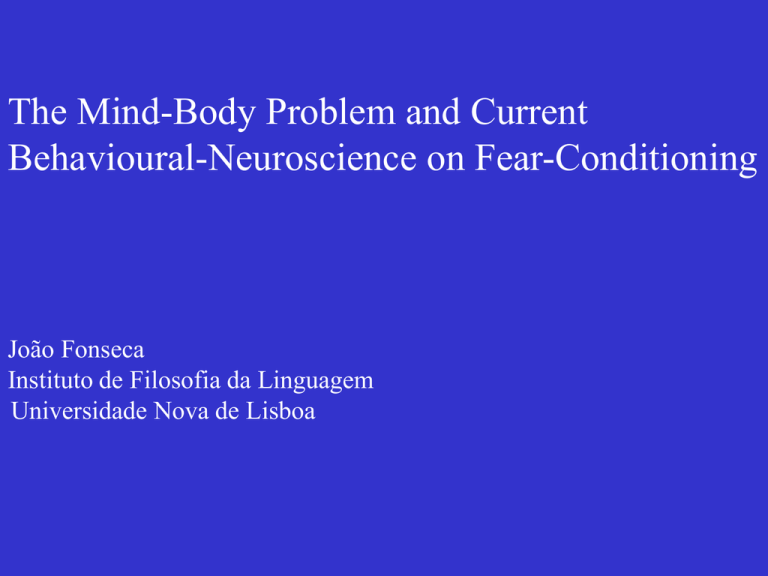
The Mind-Body Problem and Current Behavioural-Neuroscience on Fear-Conditioning João Fonseca Instituto de Filosofia da Linguagem Universidade Nova de Lisboa What is the Mind-Body Problem? There are several technical ways of presenting and defining the Mind-Body Problem For the present purposes the more or less prosaic distinction between Subjective and Objective is enough. Two distinct Domains: Objective/Body and Subjective/Mind 1- Objective: Intersubjective measurable data. Body- External objects (not just our organic body – from Quarks to Galaxies) and the physical principles (laws) that govern them. It is the domain of Physics and the other natural sciences (including Neuroscience whose external/physical object of research is the Brain) 2- Subjective: Private experiences Mind- Thoughts, Sensations, Feelings It is the domain of Introspection, Certain branches of Psychology, Phenomenology, and Philosophy So, What is the ‘Problem’ in the Mind-Body Problem? Assuming these two radically distinct domains (Mind/Subjective and Body/Objective) what is the relation between the two? For instance, the neuroscientist Joseph LeDoux states that: «the mind-body problem, the problem of how consciousness comes out of brains, [is] arguably the most difficult problem there is and ever was.» (1998, 268) This quotation can take us to a nice and smooth transition to the the question of how this problem is reflected in current neuroscientific practice. Joseph LeDoux and Fear Conditioning LeDoux innovative proposals and empirical findings on the subject of Fear Conditioning are today the mainstream paradigm used by hundreds (if not thousands…) of the neuroscience community working on this field across the globe But LeDoux’s scientific achievements are built assuming explicitly a philosophical concern: the dificulty/impossibility of explaining subjective experiences by scientific/objective means (the MindBody Problem). For LeDoux, scientific research on emotions (including ‘Fear’) should follow a path such that the mind-body problem is avoided: «[early emotion researchers] remained focused on subjective emotional experience…[t]his approach puts the mind-body problem right smack in the middle of the path of progress» (2000) Accordingly, in respect to the emotion ‘Fear’, something like I like to call ‘LeDoux’s Principle’ states that: Fear (conditioning) can and should be studied only by taking into consideration the unconscious brain mechanisms underlying that process: «I find it neither necessary nor desirable to insert a conscious state of fear into the chain of events connecting trigger stimuli to fear responses» (1998) Note that (and this is very important), LeDoux’s principle is not claiming that because of the mind-body problem there is a part of the process of fear-conditioning we have to left behind. Instead he is asserting that fear/fear-conditioning has nothing to do with subjective feelings and, therefore, we can investigate fear without facing the mind-body problem. For this reason, Fear Conditioning studies are complete, we have all necessary data. LeDoux’s line of reasoning presuppose the Mind-Body Problem (and the prior and related Mind-Body distinction) as such. But, is the Mind-Body Problem/Distinction well sustained? My claim is that it is not. This claim is sustained by somewhat complex and technical philosophical arguments that, for obvious reasons, I cannot address here. So, I suggest a different track: deny the Mind-Body Problem/Distinction and evaluate the consequences! My claim here will be that, regarding Fear Conditioning research, the consequences of denying the Mind-Body Problem consists on an enlargement of evidence. Return to Fear Conditioning research LeDoux experiments and results deal mostly with Classical Fear conditioning – US/CS pairing: reflex conditioned behavioral response (eg Freezing) Instrumental/Operant Fear Conditioning – The acquisition of an active avoidance behavior that suppresses the outcome of (noxious) US via the presentation of a CS eg: Pressing a lever in order to avoid/suppress the upcoming shock, or escape behaviors. It seems not to exist an intense research on Instrumental Fear Conditioning in Current Neuroscience Killcross et al voice this perplexity: «The role of [amygdaloid nuclei] in alternative indices of fear conditioning, including the instrumental choice responses involved in avoidance or conflict behavior, is much less clear [than reflex, pavolovian induced, responses such as freezing]» (1998) LeDoux says the following (in the “Amygdala” article from Scholarpedia): « In the 1980s, researchers began to use tasks that isolated the Pavlovian from the instrumental components of the task to study the brain mechanisms of fear. This strategy allowed a focus on the fear reaction conditioned by the shock rather than on behaviors that avoid the shock.» (He seems to consider this as an achievement or progress) LeDoux’s assumption is that the relevant brain mechanisms for Classical and Instrumental Fear Conditioning are exhausted by the former. Therefore, an exhaustive study of the neural basis of instrumental fear condition would be explanatory redundant in relation to classical conditioning. But, against LeDoux’s assumption there is some cumulative empirical evidence that suggest a double dissociation between the structures responsible for Classical Fear Conditioning and Instrumental one. In particular, several independent experiments show that the Classical Fear Conditioning neural pathway (lateral amygdala (LA) – central amygdala (CA)) is functional independent from the Instrumental one (basolateral amygdala (BLA)). Killcross et al 1997 ; Amorapanth, LeDoux & Nader, 2000 ; and others So, lets assume that Instrumental Fear Conditioning has a autonomous research path from Classical Conditioning after all. So, lets focus on Instrumental Fear Conditioning. If, according to some data (BLA – non declarative; Portavela et al, 2004, 2005), in Instrumental Fear Conditioning experimental settings, creatures do not rely on Declarative Memory in order to anticipate the US by the presentation of CS, what drives them to avoid the supposedly neutral CS? By dismissing the Mind-Body Problem/Distinction we are allowed to suppose the following ‘Crazy Hypothesis’: Maybe the Feeling of Fear is what drives them! – Their non-declarative associative memory pairs the CS with their subjective feeling of fear (the CS itself becomes noxious) We are able to formulate this hypothesis by allowing our own subjective experiences to be part of the available data and by noticing (by introspection) the similarities between our behaviors elicited/caused by our felling of fear and those behaviors being measured in Instrumental Fear Conditioning protocols (with animals). We can even suggest the following causal profile definition to the Feeling of Fear: Feeling of Fear causes active, non-stereotyped, non-reflexive (voluntary) avoidance behaviors (from the CS) This causal profile of the Feeling of Fear can assume an important explanatory role in Instrumental Fear Conditioning research. WARNING: This is just an initial working hypothesis. What follows is a simple hypothetical sketch of how this admission of the hypothesis can have an impact on empirical research. No serious scientific results are suggested!! 1st Empirical claim: If the Feeling of Fear has such a relevant causal property – with obvious survival advantages, then, [and contrarily to LeDoux’s suggestion (DLPFC)] the correlated neural structure must be a evolutionary very old one. Answer The dorsal Peraqueductal Gray (dPAG) is a very old evolutionary structure situated in the midbrain (part of the Brainstem in humans) is known for modulating fear and/or fear reactions 1- Human subjects report strong subjective feelings of fear, terror and desire to escape (similar to symptoms associated to panic attacks) during the electrical stimulation of their dPAG. Alternatively, it has been reported that spontaneous panic attacks activates this structure (interestingly, the cortex does not play any role on these more extremes cases of Feeling of Fear in humans – contradicting LeDoux’s assumption in the contrary). 2- In animals/mice, electrical stimulation of the dPAG elicits strong active avoidance behavior, including escape, running, alertness and even instrumental behavior like pressing a lever in order to stop the electrical stimulation. 3- The dPAG is present across species (vertebrates – not only mammals) and with similar functional properties (non-dependent on the existence of a cortex!). 2nd Empirical Claim If, taking into consideration the evidence stating that: 1- the BLA is critically involved in ‘Instrumental Fear Conditioning’ and 2- there is a correlation between the dPAG and the Feeling of Fear, then, according to the hypothesis tha the ‘Feeling of Fear’ has a causal-explanatory role on Instrumental Fear conditioning, some sort of structural connection between BLA and dPAG is required. Answer Here again, a lot of recent empirical results stress the existence of direct (bi-directional) pathways between the BLA and dPAG. In particular, these body of research shows that the BLA is responsible for the menemonic (conditioning) aspect whereas the dPAG is responsible for the emotional processing and responses, eg: Brandão et al, 2008; Oliveira et al, 2004; Zanoveli, 2008. 3rd Empirical Claim Taking into consideration the Feeling of Fear causal profile [(Feeling of Fear causes active, non-stereotyped, non-reflexive (voluntary) avoidance behaviors (from the CS)], the correlated neural structure (the dPAG) should not establish direct pathways with pre-specified reflexive motor outputs. This can suggest evidence for a non-deterministic causal role of a noxious feeling (Fear) the animal avoids by adopting the most adequate behavioral strategy in a certain environmental/situational condition. Answer In fact, recent studies strongly suggest that dPAG satisfies this condition. On this respect, Brandão et al states that: «[W]hereas the vPAG is involved in the motor aspects of freezing response through descending projections to the spinal cord, the dPAG activates this defensive posture through ascending projections to rostral structures» (2008, 7) I.e., whereas the vPAG establishes downward projections to motor responses, the dPAG does not and influences upstream decision-making structures (like the superior colliculus) So, (some sort of) concluding Denying the Mind-Body Problem/Distinction allows us to mesh traditional ‘subjective’ and ‘objective’ data. More particularly, we are able to suggest a causal profile for the ‘Feeling of Fear’, thus enabling it to be part of the ‘objective’ structure of the world. As a practical consequence it was shown that a greater explanatory power is gained if compared with LeDoux research paradigm which is almost mute regarding Instrumental Fear Conditioning . This suggests an unification of several disperse and scattered data from different and unrelated sources from contemporary neuroscience into a single explanatory scheme of ‘Instrumental Fear Conditioning’) I hope I have shown how the current formulation of the Mind-Body problem is constraining contemporary research on Fear-Conditioning. The adoption of Mind-Body Problem/Distinction can act as a dogma and stagnate scientific progress. We have, therefore, good pragmatic reasons to abandon the Mind-Body Problem/Distinction

